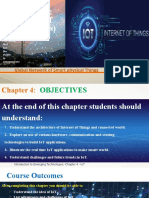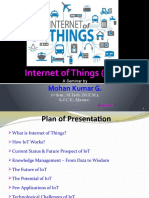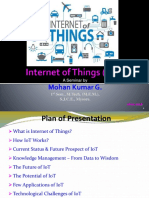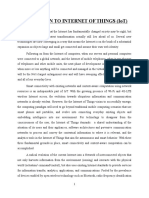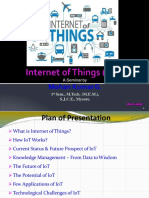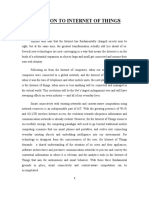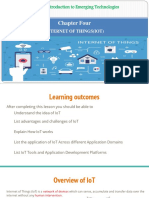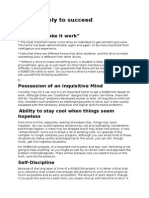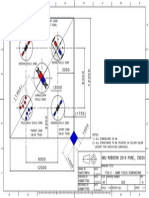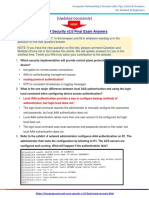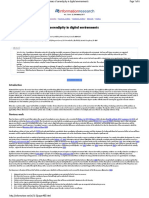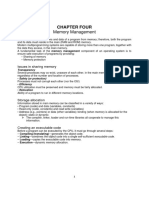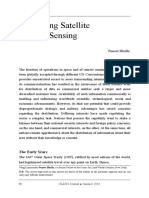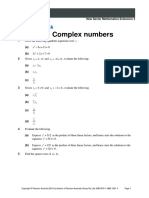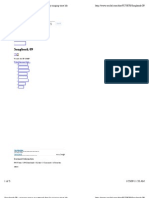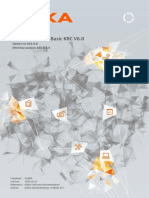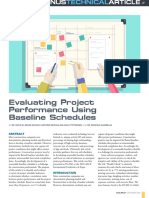Overview of the
Internet of Things
(IoTs)
Fall 2013
Qian Zhang
FYTGS, HKUST
�Ice-breaking
�Course Info
Instructor: Qian Zhang
www.cse.ust.hk/~qianzh
Course web site
http://www.cse.ust.hk/~qianzh/FYTGS5100/fall
2013/index.html
contains all notes, announcements, etc.
Check it regularly!
Lecture schedule
Wednesday 18:30-21:20 Rm 2406
�Course Info
The reading materials online for paper reading
and student presentation
Check recent research papers from high
quality conferences and transactions
Experience networking research through team
projects (1-2 students)
Understand what is good research
Hands-on experience in IoT related research
Appreciate team work / collaborations
�Course Info
Grading scheme
Homework
Project
Presentation
Final Exam
20 points
25 points
20 points
35 points
Paper presentation
Everyone reviews and presents 1 paper
Email me ids of 3 papers that youd like to
present by Sept. 28
Submit a review for one paper of your
choice before you present the paper (1-2
pages)
�Course Schedule
Introduction of the Internet of Things (IoT) (1
week)
RFID: technology and applications (1 weeks)
Wireless and mobile communications (3.5
weeks)
Sensors and wireless sensor networks (3.5
weeks)
Localization technologies (1 week)
Project preparation (1 week)
Student presentation (2 weeks)
�Outline
1 Whats Internet of Things (IoT)
2
State of the Art of IoT
3 Challenges and Limitation of IoT
4
Future of IoT
�Starting from the
Internet
Internet appears everywhere in the world
but it is still a connection between people and people
�What is the Internet of
Things?
Internet connects all people, so it is called the Internet
of People
IoT connects all things, so it is called the Internet of
Things
�Whats the Internet of Things
Definition
(1) The Internet of Things, also called The
Internet of Objects, refers to a wireless network
between objects, usually the network will be
wireless
and
self-configuring,
such
as
household appliances.
------Wikipedia
(2) By embedding short-range mobile
transceivers into a wide array of additional
gadgets and everyday items, enabling new
forms of communication between people and
things, and between things themselves.
------WSIS
�Whats the Internet of Things
Definition
(3) The term "Internet of Things" has come to
describe a number of technologies and
research disciplines that enable the Internet to
reach out into the real world of physical
objects.
------IoT
2008
(4) Things having identities and virtual
personalities operating in smart spaces using
intelligent
interfaces
to
connect
and
communicate within social, environmental, and
user contexts.
-------IoT in 2020
�Whats the Internet of Things
History
1997, The Internet of Things is the seventh in the
series of ITU
Internet Reports originally launched in
1997 under the title Challenges to the Network.
1999, Auto-ID Center founded in MIT
2003, EPC Global founded in MIT
2005, Four important technologies of the internet of
things was
proposed in WSIS conference.
2008, First international conference of internet of
things: The IOT
2008 was held at Zurich.
�Whats the Internet of Things
From any time ,any place connectivity for
anyone, we will now have connectivity for
anything!
�Whats the Internet of Things
Characteristics
Ambient
Intelligence
Event
Driven
Internet of
Things
Complex
Access
Technologies
Semantic
Sharing
Flexible
Structure
�Why Internet of Things
Dynamic control of industry and daily life
Improve the resource utilization ratio
Better relationship between human and nature
Forming an intellectual entity by integrating
human society and physical systems
�Why Internet of Things (ii)
Flexible configuration, P&P
Universal transport & internetworking
Accessibility & Usability?
Acts as technologies integrator
�Things Connected: communicated
between physical world and information
world
�Epoch of IOT
Wen Jiabao: sensing Chin
2009
IBM: Smart Planet, Winning in China
2009
Obama: Business Round Table
2009
IBM: Smart Planet
2008
2005
MIT: Auto-ID-Center
1999
18
ITU: ITU Internet Reports
�Premier Wen and Sensing
China
Premier Wen visited Wuxi in August 7, 2009.
He proposed Sensing China.
�15-Year Law
1965 Main Frame
1980 PC
1995 Internet
2010 ?
�The Application of IoT(1)
Regional Office
House
Transportation Vehicle
Biosensor taken by people
Network
Equipment
in public
place
Virtual Environment
�The Application of IoT(2)
Scenario: shopping
(2) When shopping in the
market, the goods will
introduce themselves.
(1) When entering the doors,
scanners will identify the tags
on her clothing.
(4) When paying for the goods,
the microchip of the credit card
will communicate with checkout
reader.
(3) When moving the goods, the
reader will tell the staff to put a
new one.
�The Application of IoT(3)
Scenario: Health Care
Various sensors for
various conditions
Example ICP sensor:
Short or long term
monitoring of pressure
in the brain cavity
Implanted in the brain
cavity and senses the
increase of pressure
Sensor and associated
electronics
encapsulated in safe
and biodegradable
material
External RF reader
powers the unit and
receives the signal
Stability over 30 days
�The Application of IoT(3)
Scenario: Health Care
National Health Information
Network, Electronic Patient Record
Home care: monitoring and control
Pulse oximeters, blood glucose monitors,
infusion pumps, accelerometers,
Operating Room of the Future
Closed loop monitoring and control; multiple
treatment stations, plug and play devices;
robotic microsurgery
System coordination challenge
Progress in bioinformatics: gene,
protein expression, systems biology,
disease dynamics, control
mechanisms
�The Application of IoT(4)
Scenario: Intelligent Home
Remote monitor
for smart house
Remote control for
smart appliance
�The Application of IoT(5)
Scenario: Transportation
A network of sensors set up throughout a vehicle can
interact with its surroundings to provide valuable feedback
on local roads, weather and traffic conditions to the car
driver, enabling adaptive drive systems to respond
accordingly
This may involve automatic activation of braking systems or
speed control via fuel management systems. Condition and
event detection sensors can activate systems to maintain
driver and passenger comfort and safety through the use of
airbags and seatbelt pre-tensioning
Sensors for fatigue and mood monitoring based on driving
conditions, driver behaviour and facial indicators can
interact
to ensure safe driving by activating warning systems
or directly controlling the vehicle
�The Application of IoT(5)
Scenario: Transportation
In 2005, 30 90 processors per car
Engine control, Break system, Airbag deployment system
Windshield wiper, Door locks, Entertainment system
Cars are sensors and actuators in V2V
networks
Active networked safety alerts
Autonomous navigation
Future Transportation Systems
Incorporate both single person and mass transportation vehicles,
air and ground transportations.
Achieve efficiency, safety, stability using real-time control and
optimization.
�The Application of IoT(6)
Scenario : Monitoring the
Environment
�Life in IoT Era
ITU has described the scene of IoT era
as follows
The car will generate alarm
automatically if the driver has made
any mistake during the operation;
The bag will send out reminder
message if the owner forgot bring
something;
The cloth will tell the washing-machine
about its requirement for the water
temperature;
Life will be changed completely with
the technology of IoT
�4 Layers Model for IoT
Information
Application
Information
Processing
Information
Transmission
Integrated Application Layer
Management Layer
Network Construction Layer
Information
Generation Sense and Identification Layer
�More on 4 Layers Model
Integrate
d
Applicati
on
Informati
on
Processi
ng
Smart
Logistic
Smart Grid Green
Building
Data Center
Search
Engine
Smart
Decision
WWAN
Network
Construct
ion
Smart TransportEnv.
Monitor
Info. SecurityData Mining
WMAN
Internet
WPAN
Sensing
and
Identificati
GPS
Smart
WLAN
RFID
Sensor
Sensor
�State of the Art of IoT
Enabling Technologies
RFID
To
identify
and track
the data
of things
Sensor
To collect
and
process
the data to
detect the
changes in
the
physical
status of
things
Smart Tech
To enhance
the power of
the network
by devolving
processing
capabilities
to different
part of the
network.
Nano Tech
To make
the smaller
and
smaller
things have
the ability
to connect
and
interact.
�Sensor Technology
The ability to detect changes in the physical status
of things is essential for recording changes in the
environment.
Wireless sensor technology play a pivotal role in
bridging the gap between the physical and virtual
worlds, and enabling things to respond to changes
in their physical environment. Sensors collect data
from their environment, generating information
and raising awareness about context.
Example: sensors in an electronic jacket can collect
information about changes in external temperature and the
parameters of the jacket can be adjusted accordingly
�State of the Art of IoT
Research Groups
1
MIT Auto-ID Lab &
EPC Global.
Stanford University
Georgia Institute of
Technology
Cambridge Univ
2
EPFL & ETH Zurich
Information and
Communication
Systems Research
Group
Chemnitz University
of Technology
VSR Group
3
Nokia
SAP
IBM
GOOGLE
AMBIENT
Metro Group
Siemens
Sun
Cisco
GE
�State of the Art of IoT
�The Challenge of IoT
Total challenge of IoT
1. Technological Standardization in most areas
are still remain fragmented.
2. managing and fostering rapid innovation is a
challenge for governments
3. privacy and security
4. Absence of governance
�The Challenge of IoT
How
How to
to convincing
convincing users
users that
that the
the IoT
IoT technology
technology will
will
protect
protect their
their data
data and
and privacy
privacy when
when tracking
tracking
Potential Solutions
Legal &
Regulator
y
Technical
Control
Social Ethic
Market
Self-regulation
�IoT and WSN
WSN is IoT IoT aka WSN IoT WSN
IoT aka RFID + PerCom
IoT is not WSN IoT WSN
IoT contains WSN IoT WSN
�IoT and WSN
Things are diverse
They might be individual like water,
soldiers, trees
They also be a set of individuals like
ocean, battlefield, forest,
�IoT and WSN
We concern not only about water, tree and
soldier, but also about ocean, forest and
battlefield.
�IoT and WSN
So we have ocean monitoring, Forest
management, battlefield control.
�When WSN is Used
To Connect digital world and physical world
Sensed
data
Digital
World
Sensed
data
Sensed
data
Sensed
data
Sensed
data
Sensed
data
Physical
World
�IoT and CPS
CPS
C1
C2
Cn
P1
P2
Pn
C=C1 C2
P=P1 P2
Cn
Pn
Internet or
Cyber world
IoT
�IoT and Pervasive Computing
�CPS and Pervasive
Computing
All such buzzwords refers to the same balloon. When it is
blasted to large size, it is called Smart Planet; when to
middle size, it is called CPS; When to small size, it is
called pervasive or embedded system.
�Internet of Things vs. Cloud
Properties
�Internet of Things, Cloud and
Services
Internet of Things enables
High-resolution management
Real-world control
Adaptive processes
IoT Issue
Possible Solution
Heterogeneity
Services as abstraction layer
Application
Development
Mash-up of services
Solution Deployment
Support through XaaS models
Producing a lot of
data
Processing of large data quantities in
the cloud
IoT, Cloud, and Services are complementary aspects
of a Real World Internet
�2 Examples
For the public and the society
For business and enterprises
�Example 1: Pachube
"The Internet of Things Real-Time Web
Service and Applications"
Platform to connect sensors and other hardware
Platform to build IoT services and applications
RESTful APIs
�After the Fukushima Disaster
on Pachube
�Many People Connected
Radiation Sensors
�Cool, but
Data quality of various sources
Accuracy of each data point
Sensor reliability and availability
Time of measurement
Important for trust!
Unit jungle:
nGy/s, mSv/h, Sv/h, Bq/kg, cpm
Sometimes misleading, sometimes just hard to
compare
Mix of data sources
Real sensors
Virtual sensors (data scraping from web pages, e.g.,
http://www.houshasen-prefibaraki.jp/present/result01.html)
�Business Web
A Platform and Marketplace for Business
Services
The Business Web is a cloud-based business
environment that provides access to the necessary
infrastructure, applications, content, and connectivity to
deliver end-to-end business services optimized for
mobility and ease of participation
�Business Web:
First-class Internet of Things
Integration
�M2M Scenario Ice Cream
Cabinets
The application provides consumer
products companies with detailed
information about the location and
status of its ice cream cabinets.
This information can be used to
find these cabinets, supply them
with new ice cream in time, and
monitor their temperature in order
to avoid ice cream becoming bad
due to a defective ice cream
cabinet.
The ice cream cabinets become
smart items that monitor their
energy consumption, send alarms,
and become an active part in the
companies operation processes as
well as sustainability efforts.
�IoT Configuration
2.5 million ice cream cabinets
Worldwide distributed
Biggest growth markets: China
and India
Sensing
Need to refill
Avoid stock-outs
Location
Reliably find and refill
Temperature / power outage
Detect failures and avoid product
loss
Behavioral statistics
Conclude conversion rate
Estimated business value:
>5% increased sales
�IoT Integration into Business
Processes
Roles and processes
3rd Party Supplier
CPG Backend
Operational BI on supply chain
efficiency
User behavior monitoring and campaign
efficiency
3rd Party Supplier
Dispatcher: Improved planning of daily
logistics processes
Get refill priorities and alarms on power
outage and temperatures
Truck Driver: Guidance and real-time
integration into process
Store Owner
Push alarms to store owners for
immediate actions
Resolve power outage / close lid to save
energy
Consumer
Guidance to next ice cream cabinet
(source of happiness)
Consumer
Augmente
d
Reality
App:
Guide me
to the
next ice
cream
�Business Value
Ice Cream Business is a 60+ billion
market
Highest margin business in food
CPG
10.5%
Unilever
10+ billion in ice cream sales
Market leader in out-of-home ice
cream business
30% market share
2/3 is out-of-home business
ICC scenario estimated benefit is
45 million additional profit per year
Phase 1: Pilot
500 ICCs in Germany, 50 mobile
users
Phase 2:
10.000 ICCs in Germany, 1.000
users
�Short Summary
Internet of Things, Cloud Computing and
Services are all aspects of a (Future) Internet
Strengths of each can and should be combined
Examples of successful combinations exist
Both in the public and the business domain
We are at the beginning of an interesting
journey
Many challenges still lie ahead
�Road is Difficult, but Future is
Bright
Any TIME
Any PLACE
Any THING







